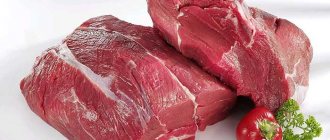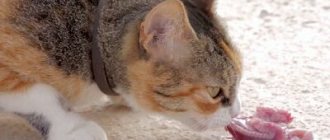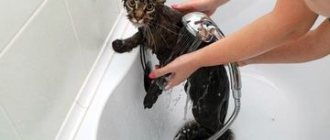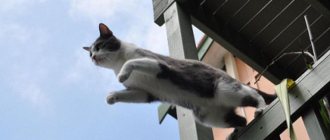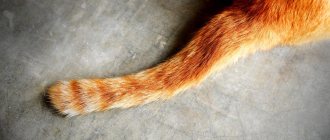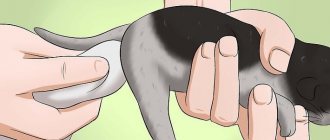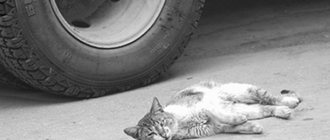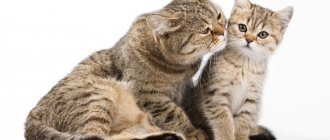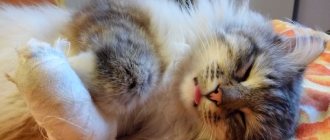Where does a cat secrete sweat?
The sweating system is extremely important as it helps improve heat exchange and prevent the body from overheating. Domestic furry predators are distinguished by such a feature that they have very few sweat glands.
Cat's reaction to heat
So do cats sweat? Sweat glands in cats are located only between the toes, in the area of the lips, cheeks, around the nipples and anus. In this, cats are similar to dogs. Therefore, a healthy animal produces very little sweat and only in the above-mentioned parts of the body. This is how cats sweat. In the summer, you can notice rashes from wet paws - this is the release of sweat from the pads.
Interesting! Cats have two types of glands: eccrine and apocrine. The first type includes the glands located on the paws, and the second type includes the rest.
Pets are able to secrete sweat not only in hot weather, but also when nervous. A person also has this characteristic - his palms begin to sweat at the moment of any emotional stress.
Description of dog sweat glands
Dogs have two types of sweat glands - some help cool the body and others do not. The apocrine sweat gland does not participate in lowering body temperature because it has a different purpose. This type of sweat gland is considered the main one in dogs. Each hair follicle has its own apocrine gland, so your dog is practically covered in these beneficial sweat glands. The primary function of the apocrine glands is the release of hormones, which at a chemical level give signals to other dogs, but do not at all contribute to the release of moisture, the removal of which helps reduce body temperature. The sweat that is excreted through the apocrine glands is oily but odorless, but that is only until it mixes with skin-resident bacteria, which give the sweat its odor. Merocrine or eccrine sweat glands are the main type of sweat glands in humans. Dogs also have this type of sweat gland, but they are found on their paw pads and possibly on their nose. The eccrine glands produce sweat, which is primarily composed of sodium chloride and water. Areas of the skin where there is little to no hair, such as the paw pads and nose, have the ability to remove moisture in the form of sweat through the merocrine glands, which are activated when the body heats up. This explains why veterinarians see wet paw prints on their perfectly clean examination tables every day.
How do cats cool down?
If the sweating system helps cool the body, then how do cats, which have so few corresponding glands, escape from overheating? Due to the thick fur, the released liquid evaporates without cooling the animal's body.
Do dogs sweat: do they have sweat glands?
An interesting fact is that the glands secrete sweat not to allow the skin and body to cool, but for odor marking. With the help of secretions (sweat), cats mark their territory. Even when they sharpen their claws on furniture, they can secrete a secretion for the same reason. Therefore, it is not sweat that helps pets cool themselves, but other methods:
- Licking. When washing, the cat begins to cover its fur with saliva, thereby the liquid evaporates and cools the body. An animal's saliva consists of water, salts and enzymes. The salty liquid evaporates quickly, which helps lower body temperature. Also, with a large amount of saliva, the cat begins to experience a salt deficiency, which means that the body begins to produce heat more slowly.
- Decreased activity. To cool down, the cat begins to move a little or sleep a lot. This way the temperature remains at the same level.
- Body position. The cat stretches, looks for shade - this helps to cool the body from the outside.
- Drink. In hot weather, animals begin to drink more water, which promotes the secretion of saliva, thins the blood and restores water balance in the body.
- Wool. It is believed that keeping the fur close to the cat's body helps it cool down. And when it is fluffed, the body is warmed, since the air between the hairs retains heat inside.
Important! Kittens have imperfect thermoregulation, so they quickly freeze or warm up. The kitten cannot help itself to warm up or cool down, so it needs help to overcome the discomfort. In nature, the mother is responsible for this - she licks the cubs and warms them.
The cat curls up into a ball from the cold
Reviews about cats sweating
It's been a little over a year since our Canadian Sphynx appeared. The cat is very affectionate, treats everyone in the house equally (he loves and is ready to spend as much time with everyone as they are willing to devote to him), but there is a HUGE MINUS that for some reason the breeders are silent about - this is sweating, which eventually stains both clothes, clothes and EVERYTHING carpets (rugs) located in the house! Those places where the cat lies... are constantly dirty, that is, when I come home from work, I have to run and wash the floors (morning and evening) and make sure that he doesn’t rub himself near things, because he will get everything dirty (
Sphinxes are sweating. But this sweat smells nice and doesn’t cause any disgust. And then you will only at first think that how come a cat climbed into bed or lay on a pillow, and you also lie on it... And then you will even be pleased. When a cat presses its warm body against you, right against your cheek, it’s a great feeling! And the dirt is from all the animals. But also from people. smile.gif So if you clean on time, you will get the cleanliness that you need.
Cats are naturally equipped with a thermoregulatory mechanism. However, it cannot be called perfect. The cat produces sweat, but it is negligible, and it does not contribute to cooling the body as a whole. Pets that permanently live in city apartments or private houses have a dulled perception of heat and cold. As a result, heat strokes are possible. When the owner is attentive to his pet, many problems disappear on their own or do not arise at all.
- Veronica Eremenko
How to tell if a cat is hot or cold
Mammary cancer in a cat: breast tumor
Some symptoms can easily determine whether a cat is cold or, on the contrary, very hot.
When a pet is cold, it:
- curls up into a ball;
- hides nose;
- sits ruffled;
- demands to eat more often;
- trying to move more.
When a cat is hot, it:
- lies stretched out;
- looking for shade;
- licks himself a lot;
- drinks water often.
The owner of the cat should help her in every possible way: do not forget to pour water into the bowl during the hot season and not force her to move a lot.
How to prevent overheating in cats
In very hot weather, cats may experience overheating. This can have a detrimental effect on the animal’s health, so the owner needs to monitor the pet’s behavior and try to prevent such a problem.
How many nipples does a cat have? Do cats have them?
Signs of a cat overheating:
- breathing with an open mouth and raised tongue;
- deep, sharp and abrupt sighs;
- wetness of paw pads;
- weakness;
- lack of appetite;
- cardiopalmus.
Having your cat breathe with its mouth open helps it breathe in moist, cooler air. Thus, the walls of the nasopharynx and lungs cool faster, and body temperature decreases.
Note! It should be understood that sometimes breathing with your mouth open is a warning sign. It is necessary to monitor the cat’s condition, as there is such a thing as “heatstroke”. The owner must correctly interpret the symptoms and provide emergency assistance.
How to recognize that a cat has heatstroke? This is indicated by an elevated temperature, which the cat is unable to reduce on its own or from the outside. The norm is 38-39 °C, and for kittens – up to 39.5 °C. At elevated body temperatures, blood becomes thicker and circulates poorly throughout the body, which leads to the accumulation of toxins and even stroke.
Important! Breathing with your mouth open is not always a sign of heatstroke. A cat can breathe through its nose but still need help.
Sticking out tongue is a sign of overheating
After measuring the temperature (rectally) and confirming that it is not normal, you should first:
- Give your pet water, and if he refuses, then force it.
- Moisten the cat's fur with water.
- Apply a cool (not cold!) towel to your ears. The skin on the ears is thin, so cooling occurs faster.
- Gently dip the cat's body into a bowl of water at room temperature. Never in the cold - this can provoke an attack!
If after this the animal does not feel better within 10 minutes, then immediate medical intervention is necessary.
When to contact him immediately:
- the cat breathes with its mouth open and there is a blue discoloration of the mucous membranes - evidence of heart failure;
- redness of the tongue and gums;
- the pet’s loss of orientation in space, lost gaze, too dilated or constricted pupils;
- weak, slow pulse;
- short sighs, weak and slow breathing - an attack of respiratory failure;
- vomiting, excessive salivation, mucus discharge from the nose;
- unpleasant odor from the mouth;
- convulsions;
- dyspnea;
- lack of response to external stimuli;
- coma (in rare cases).
Additional Information! Pets with short and flat faces, such as Persians, kittens, pregnant or older cats, are more susceptible to overheating.
You should not allow the animal to be in direct sunlight for a long time; you need to monitor its body temperature, behavior and the availability of fresh drinking water. During the hot season, you should ventilate your apartment or house more often. You should never leave an animal without air in an enclosed space, such as a car.
What causes profuse sweating?
Excessive sweating is not typical for cats, so if this symptom appears, the owner should be wary. It can be a sign of both exposure to unfavorable factors and pathological conditions.
Diseases
When an owner notices that their pet is leaving wet marks more than usual, this may be a warning sign for them. Excessive sweating in your pet can be a symptom of various diseases. First of all, those associated with increased temperature:
- hemobartonellosis - an infectious bacterial disease that affects blood cells;
- feline AIDS, a viral disease that suppresses the immune system;
- viral leukemia - a disease associated with suppression of bone marrow functions;
- flu;
- infectious peritonitis, a fatal infection that attacks the immune system of cats;
- upper respiratory tract infections;
- panleukopenia - “distemper”, a viral disease that affects many systems of the cat’s body;
- toxoplasmosis is an infection caused by microscopic parasites.
Naturally, each of these pathologies is accompanied by a number of other symptoms. However, primary signs, which include profuse sweating, are prerequisites for urgent contact with a veterinarian.
Stress
In addition to illness, excessive sweating can cause stress. Most often, this condition is provoked by factors that irritate the nervous system, causing changes in the functioning of organs.
Stress can be short-term or it can last for a long time. Short-term stress most often passes painlessly. If an animal is stressed for a long time, then a malfunction of some system (for example, a thermoregulation system) or a disease occurs.
Causes of stress can be:
- physical damage, such as burns or injuries;
An injury to a cat is a stressful situation for it, especially if it is accompanied by long-term treatment.
- poisoning;
- hunger, vitamin deficiency;
- emotional disorders, for example, associated with moving, inattentive owner, etc.
Overheat
As the weather gets hotter, many cats may suffer from overheating. This condition may result in dysfunction of thermoregulation. A cat's body temperature can rise to 41 degrees. Signs of pathology are always clearly expressed. Prolonged overheating can be fatal. Those most susceptible to heat stroke are:
- kittens;
- pregnant cats;
- older animals.
These categories of animals are at risk because their bodies are weakened due to age or physiology. Also at risk are cats whose breed suggests a brachycephalic skull structure. In cats with a shortened muzzle, heat exchange processes are worse. This becomes a reason to pay closer attention to pets during the heat.
Cats with very long hair or thick undercoat are also at greater risk of heatstroke than others. Signs of overheating include:
- unnatural spread-eagled pose;
- breathing through the mouth with the tongue sticking out;
A cat breathing with its mouth open is a sign that the animal is overheating.
- shortness of breath;
- redness of the tongue and gums (bright red), but, on the contrary, atypical pallor is possible;
- wetness of paw pads;
- weakness and apathy;
- lack of appetite;
- severe drooling;
- vomiting with foam;
- convulsions;
- to whom (possible in severe cases).
I first observed overheating of an animal in my Thai cat. We lived in an apartment, but often went for walks together; she walked perfectly on a harness and even without it, not lagging behind me more than 4-5 steps. Not far from the house there was a forest and a meadow. And then one autumn (Indian summer) we went for a walk. The sun was shining and the weather was beautiful. About twenty minutes later, the cat began to leave the path and lie down in the thickets of grass on its side. I chalked it up to being tired; after all, we didn’t go for walks every day, and at home the animal had virtually no conditions for physical exercise. I gave her a few minutes of breathing space and then moved on. My “faithful dog” got up and followed me. And then I saw that the cat opened its mouth, stuck out its tongue and began to breathe heavily. I didn’t know how dangerous this condition was, but out of compassion for the animal, the walk ended there; the pet got home in my arms. Only later did I find out. that a cat's breathing is a sure sign of overheating, not fatigue.
Some advice for cat owners
The owner of a fluffy beauty should always monitor her health. Do cats sweat, regardless of the temperature indoors or outdoors? Even though cats have few sweat glands, they can sweat profusely. What this is connected with is described below.
Disease
If the owner notices that the cat’s fur has become greasy, the body temperature is increased, it leaves wet paw marks, but there could be no overheating, then he should consult a doctor, as this is a clear sign of the following pet diseases:
- infection;
- AIDS;
- leukemia;
- flu;
- panleukopenia (“plague”).
If treatment is not started in time, death will be guaranteed. There are other signs of these diseases, sweating is just one of them.
The animal's greasy fur is caused by excessive sweating.
Stress
Many factors can trigger stress in a cat, causing it to sweat profusely. Irritation of the nervous system can cause:
- physical damage;
- poisoning;
- avitaminosis;
- hunger;
- emotional disorder (moving, lack of attention, etc.).
Overheat
You should always keep an eye on your cat during the hot season, especially long-haired breeds. The owner should comb the coat more often, or cut it completely in the summer. Cats should also be allowed into cool places, such as the bathroom tiles.
Signs and causes of thermoregulation disorders
Even though cats can take care of their thermoregulation on their own, sometimes they find themselves in situations where they need help from an owner or even a veterinarian.
There are several reasons why thermoregulation is disrupted in cats.
Overheating (heatstroke)
Due to increased air temperature, a cat’s blood becomes thicker and its circulation rate decreases. As a result, intoxication of the body occurs, and the risk of disruption of vital organs (kidneys, liver, respiratory system) increases.
In addition, with overheating, there is a high probability of developing a stroke, thrombosis and, as a consequence, death.
Main signs of heat stroke:
- convulsions;
- trembling throughout the body;
- open mouth breathing;
- a sharp increase in body temperature to 41–43°C;
- drowsiness;
- salivation;
- refusal to eat;
- redness and dryness of mucous membranes;
- increased heart rate and pulse;
- wetness of paw pads;
- dyspnea;
- weakness;
- vomit.
The most susceptible to heatstroke are very young kittens, pregnant and elderly pets, as well as long-haired cats and individuals with a brachycephalic skull structure (for example, Persians).
Stress
Stressful situations are often the cause of excessive sweating. Typically, this condition occurs due to the influence of factors that irritate the nervous system. As a result, the cat's internal organs are disrupted.
Causes of stress can be:
- poisoning;
- injuries;
- avitaminosis;
- hunger;
- moving;
- lack of attention from the owner;
- the arrival of a new pet or family member in the house.
Stress in representatives of the cat family can be short-term and long-term. Symptoms of short-term stress in pets are almost invisible, but for long-term stress it is recommended to show the cat to a doctor.
Diseases
Among other reasons, a cat may actively sweat if it develops any disease:
- toxoplasmosis;
- infectious peritonitis;
- panleukopenia;
- upper respiratory tract infections;
- flu;
- viral leukemia;
- hemobartonellosis (infectious anemia);
- viral immunodeficiency of cats.
In addition to active sweating, all of these diseases have other symptoms (for example, vomiting, diarrhea, runny nose, shortness of breath, swollen lymph nodes, pale mucous membranes).
If there are any changes in your pet's health that are accompanied by excessive sweating, you should take him to a veterinarian as soon as possible.
Do Sphynx cats sweat?
What to do if the cat has no hair at all? The Sphynx cat differs from other felines in the absence of fur on the body, and therefore thermoregulation. But this does not mean that the Sphynx is not susceptible to heat stroke.
Their peculiarity is that they sweat throughout their entire body, rather than in just a few areas. Since these cats do not have fur, they are not protected from temperature changes like other breeds. But sphinxes are not completely defenseless. Nature has made the body temperature of hairless cats 1 degree higher than that of woolen pets. Accordingly, the sweat glands cool the Sphinx more actively to prevent heat stroke.
All this leads to the fact that such cats get dirty faster and leave dirty marks on the furniture. The more the Sphynx sweats, the dirtier it becomes. It depends on his state of health or emotional stress. Therefore, such cats should be washed or wiped with a damp cloth more often, otherwise the accumulation of large amounts of fat and sweat on the animal’s body can provoke the appearance of bacteria and skin diseases.
Sphinx
You need to monitor your pet's health. If your cat is sweating profusely, you should immediately consult a doctor. It is always necessary to monitor the cat’s nutrition and the temperature in the room so that the animal feels comfortable.
It so happened that a year ago a feline of an exotic nationality, a Canadian Sphynx named Sheela, moved into the apartment. The creature looked ominous: with huge translucent ears, narrowed, unkind eyes and numerous folds of gray skin, and was intended as a gift for my mother.
Since there were no exotics in my life before, I, as an advanced user, began to study forums on communicating with sphinxes. And I really regretted that I didn’t think about it before I brought the kitten home.
Dictator Sheela
Sheela is completely different from ordinary domestic cats. And it’s not just the unusually long hind legs, the eternally cold, rat-like bare tail, and the exorbitant appetite. Perhaps Sheila was a dictator in a past life. Or a swamp kikimora. Or - the only and beloved daughter of the Turkish Khan. In any case, the creature behaved accordingly.
The older cat, a true phlegmatic person, a lover of sofas and Zen, was at first perplexed by the new dwelling. She ate too much, managing to take out all the food from her bowl in a minute, like an excavator bucket, and then, cheerfully pushing her neighbor away from his bowl, she destroyed his portion. The cat, being the eldest, lazy and a man at the same time, endured (and at night I, looking around furtively, fed my pet behind the tightly closed kitchen door, because this gray misunderstanding mystically sensed food and rushed to the catering unit). True, then he learned to eat at military speed.
In matters of food, the sphinx turned out to be a problem-free creature, and with equal joy it eats everything: from sauerkraut and bell pepper to ice cream and dietary soup. Of course, she almost never gets this, in a bowl - decent quality dry food. But Sheila is always happy to climb into the trash can and pull out some delicacy. And the sphinx will never refuse to scrub the dog away from the bowl and treat himself to its food. Such an immodest appetite is the consequence of the fact that the cat has no fur. In order to warm herself, she needs a lot of energy.
Then the growing sphinx, whose breed-natural temperament requires games and fun always, if this very temperament does not sleep, began to bully her friend. Have you seen the picture on the Internet “My lion, I do what I want”? So, Sheila decided that she was a lioness. And her motto is humiliate, dominate, conquer. The cat endured having people jump on him from the closet and grab his neck with sharp teeth, grab his furry paws and gnaw his ears. It was clearly visible in his eyes: “Gods, for what?”
Then the cat learned to hide. And he and Shila began a real family life. The Sphinx attacked him like a wife from a joke asking: “Where did you put the money, you bastard?” The cat endured it, trying to hide his fillet and scruff at the same time, and then went “to the garage”, next to our dog. By the way, the dog gets it too. But the dog doesn’t react, he’s already used to it.
Loving exotic
Like any sphinx, Sheela chose one owner, whom she was ready to surround with her love day and night. True, this love is expressed in a very strange way. It’s not enough for a cat to just climb onto your lap and calm down by purring. Her unattainable dream is to climb into the mistress’s nostril. Or in the ear. And stay there to live. Sphinxes are very affectionate, and they really consider their owner “one of their own.” To ensure that no one encroaches on a person, the exotic will lick the face and hands, mark the bed and personal belongings of the owner, so be prepared that clothes and blankets will have to be washed regularly.
Hairless cats have a smell. And not very pleasant. Because sphinxes sweat (and also snore, sniffle and shake from the cold, hiccup and do not meow delicately, but scream in a loud bass voice). The owner regularly bathes her treasure in a warm bath with baby shampoo. By the way, sphinxes tolerate water procedures compared to other cats, like Spartan boys who do not cry when their hand is cut off.
But what the sphinx certainly cannot stand is loneliness. Despite their rather vicious appearance, representatives of this breed are affectionate and gentle, and need tactile contact with their owner. Therefore, having received such happiness, be prepared for the fact that disgustingly cold paws and tail will press against your body at night. And not delicate around the legs. The Sphinx will not calm down until it climbs onto a person’s chest. Or better yet, on the face.
If the owner is gone for too long (and a long time is about 20 minutes), an exotic cat may become offended and begin to take revenge in a very sophisticated way. Everything is used - from a puddle on the pillow to biting the elbows followed by a rapid retreat.
The Sphinx is very smart and quick-witted
However, these not very aristocratic character traits are balanced by others. Sheela turned out to be an extremely smart animal. And at times his habits resemble a dog. By the way, many owners of sphinxes talk about this feature.
A cat can carry an abandoned toy in its mouth for its owner to play with, and when it seizes the moment, it will put the slobbered fur mouse in its palm. Sheila also understands the phrase “You are a very, very bad cat.” And he immediately hurries to cover. She can find her friends and bring them with her - a second cat and a dog, when, for example, the distribution of gifts and treats begins.
And Shila is also very pleasant to touch. Those who believe that touching the bare skin of the sphinx is unpleasant are mistaken. In fact, rubbing a cat’s warm, corduroy-like skin, replete with folds, is a good relaxation. And since sphinxes are very affectionate, they are ready to lie under their master’s hand for hours, filling the surroundings with their uterine rumbling.
Sphinxes, by the way, are very talkative. At first, when we heard a deep mewl in the depths of our apartment at night, we were scared. And then we got used to it. Sheila, meeting the hostess at the door, hurries to share the news, humming something. Therefore, there will be no more silence in the apartment.
We also had to forget about peace - our cat, like a decent “Canadian,” turned out to be indecently curious. And just as energetic.
Breed Features
Sphynxes are very clean and stubborn cats. Therefore, such a delicate issue as arranging a “corner of thoughtfulness” becomes a headache for many owners of “Canadians”. If an exotic has decided that he wants to do “this” on the rug in the hallway, then rest assured - he will do “this” there. Even if you change not only the rug, but also the corridor. Therefore - patience, patience and more patience.
Scolding the Sphinx is pointless and naive. The only thing that will help is to find a compromise. Our purebred “elite” refused to use a standard litter box. Therefore, in the center of the corridor, like a monument, there is a meter-long plastic basin of triumphal red color, into which a torn newspaper is laid out in a special order. If the cat thinks that the newspaper is laid out somehow wrong, she will correct it herself - with her paws and nose.
A separate “hygienic” problem is the eyes. Due to the lack of hair and eyelashes (however, during puberty, Sheila had sparse curly gray hair along her spine, which happily fell out, and she also periodically has a single whisker), cats of this breed often have watery eyes. Especially on sunny days. The older the cat, the purer its unkind look. In this case, a special rinsing solution and periodic cleansing of the corners of the eyes with a baby wipe will help. In general, in terms of health, despite their sickly appearance, “Canadians” are quite hardy and do not cause concern. Especially if the owner takes care of vaccinations and regular care of the animal.
In general, whether or not to take home this strange creature, which is called the sphinx and with all its appearance, behavior and habits confirms its mystery, is, of course, an individual matter. But remember that if any animal is a personality, then the “Canadian” sincerely considers himself a superperson. And he will force, persuade, and quietly roll away everyone around him to reckon with himself. True, I can say one thing for sure. Anyone who has a sphinx will never feel lonely. Even if he wants to.
A LITTLE HISTORY
Mentions of hairless cats go back to antiquity - in documents and on art objects of those times. There is an assumption that during the time of the Aztecs they lived in temples, helping people communicate with the gods. At the end of the 19th and beginning of the 20th centuries. hairless cats were found in Mexico, where they were called Mexican hairless cats. In 1924 they first appeared at cat shows. The last pair of representatives of this breed lived until the 1930s, but, unfortunately, left no offspring.
Cases of hairless kittens being born have occasionally been found around the world, but none of them have been supported in terms of creating a new breed. A revival of interest in breeding occurred in 1966, when a hairless kitten, named Prune, was discovered in the Canadian city of Ontario due to an accidental mutation in the litter of an ordinary cat. It was he who became the ancestor of the Canadian sphinxes.
However, the breeding of hairless cats subsequently suffered a number of failures for several reasons simultaneously. Taking into account the fact of the small number of representatives of this breed and the lack of experience of breeders in working with hairless breeds, the likelihood of stabilization was very low. In addition, felinologists made a mistake in the genetics of sphinxes, believing that hairlessness is associated with the sex of the animal. Due to the lack of appropriate knowledge among phenologists, deaths were often caused by an incorrect approach to care. The breeding strategy followed by the first nurseries was also extremely unsuccessful.
But the story of the sphinxes did not end there, as new finds were soon discovered. In 1975, in the state of Minnesota, in Wadena, a simple short-haired cat gave birth to a hairless cat, who, not without humor, was named Epidermis, and a year later the same owners had a hairless cat in their house. Soon they ended up in the Z. Stardust nursery, Oregon, where they laid the foundation for the main lines of Canadian Sphynx cats, which today are among the most elite. In 1978, on the streets of Toronto, not far from the birthplace of the first Sphynx, three more hairless kittens (Bambi, Punky and Paloma) were discovered, which were immediately sent to Holland, where they laid the foundation for the formation of the European line of the breed.
In the future, the genetic pool of the Canadian Sphynx breed, both European and American lines, was maintained by crossing existing kittens with representatives of the native breed and Devon Rex, which are closest in appearance to Sphynxes. As it turned out, the Devon Rex is the only breed, mating with which naked kittens were born already in the first generation.
FOR REFERENCE
Head of the Canadian Sphynx: medium-sized in the shape of a modified wedge with rounded contours, the length of the head is slightly greater than its width. The skull is slightly rounded with a fairly flat front. On the bridge of the nose it has a light or medium stop. Well defined cheekbones. The muzzle is strongly rounded with distinct whisker pads.
Sphynx ears: wide at the base and open, very large. Standing straight, sits neither too low nor too high on the head, there is absolutely no hair on the inside; a small amount of hair is allowed on the outside at the outer base of the ears.
The eyes of the Canadian Sphynx: have a round lemon-shaped shape, large. Located elongated to the outer edge of the ears. The distance between the eyes is slightly larger than the size of the eyes. Ideally, the eye color matches the coat; greenish-brown and green are allowed.
The neck of the Canadian Sphynx: muscular, of medium length, slightly curved from the line of the shoulders to the base of the head; in males it is especially strong.
The body of the Canadian Sphynx: medium in size and build, has a medium or medium elongated format. The chest can be barrel-shaped and wide. A rounded belly means the cat has eaten well, but is not fat. The muscles are well developed, but nevertheless the cat has an elegant appearance.
Limbs: Legs of medium build, strong, muscular, proportional in length to the body, hind legs slightly longer; The front paws are set wide apart.
The paws are medium-sized oval, the fingers are graceful and very long. The paw pads are thicker than those of other breeds, giving the impression that the cat moves on air cushions.
Tail of the Canadian Sphynx: flexible and mobile, pointed from the body to the tip. Proportional to the body in length. A tuft of hair, the so-called lion's tail, is allowed at the tip.
Sphynx Coat: Delicate short hairs may be present on the paws, outside of the ears, scrotum and tail. The bridge of the nose should be covered with normal hair. On the rest of the body, the cover can vary from complete absence of hair to soft peach-colored fluff, which is no more than 2 mm. length.

